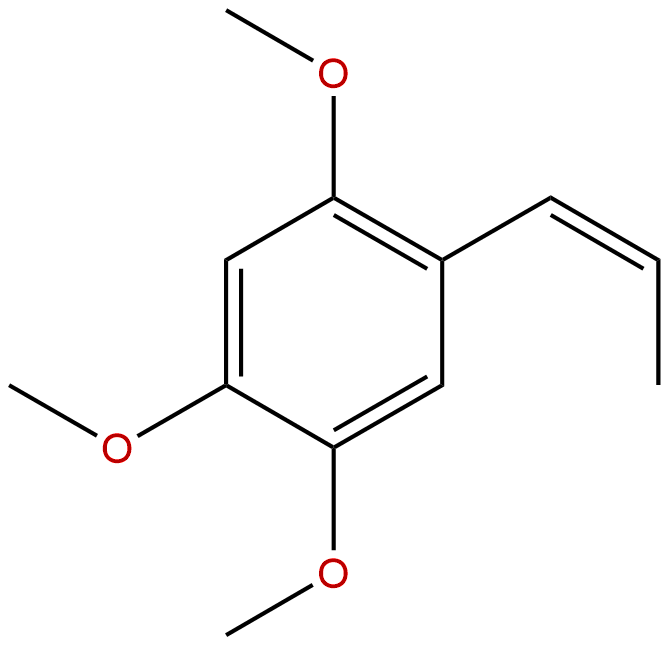
Beta-AsaroneCAS No.:5273-86-9
|
||||||||||
 |
|
|
||||||||

| Catalogue No.: | BP1852 |
| Formula: | C12H16O3 |
| Mol Weight: | 208.257 |
Product name: Beta-Asarone
Synonym name: Cis-Asarone
Catalogue No.: BP1852
Cas No.: 5273-86-9
Formula: C12H16O3
Mol Weight: 208.257
Botanical Source:
Physical Description: Oil
Type of Compound: Phenylpropanoids
Purity: 95%~99%
Analysis Method: HPLC-DAD or/and HPLC-ELSD
Identification Method: Mass, NMR
Packing: Brown vial or HDPE plastic bottle
The product could be supplied from milligrams to grams. Inquire for bulk scale.
We provide solution to improve the water-solubility of compounds, thereby facilitating the variety of activity tests and clinic uses.
For Reference Standard and R&D, Not for Human Use Directly.
Description:
beta-Asarone has neuroprotection, anti-tumor, anthelmintic, anti-inflammary, and anticoagulant effects, it can afford a beneficial inhibition on both mRNA and protein expression of Bad, Bax, and cleavage of caspases 9 in rat hippocampus following intrahippocampal injections of Abeta (1-42).beta-Asarone prevents autophagy and synaptic loss by reducing ROCK expression in SAMP8 mice. beta Asarone can cause liver and cardiac damages, it also has reproductive toxicity.
References:
Nat Prod Commun. 2009 Feb;4(2):275-8.
Compositional variations and anthelmentic activity of essential oils from rhizomes of different wild populations of Acorus calamus L. and its major component, beta-Asarone.
Hydro-distilled essential oils from Acorus calamus rhizomes collected from six different geographical zones in the northwest Himalayan region of Uttarakhand have been analyzed by GC and GC/MS.
METHODS AND RESULTS:
All the oils differed in their qualitative and quantitative make up, although beta-Asarone was the major constituent of all of them. The essential oils and the isolated beta-Asarone were screened for anthelmintic activity using contractility of Ascaridia galli. beta-Asarone, in particular, showed potent activity with IC50 values of 75.4 +/- 61.8 ng/mL.
Food Chem Toxicol. 2014 Oct;72:265-72.
β-Asarone (cis-2,4,5-trimethoxy-1-allyl phenyl), attenuates pro-inflammatory mediators by inhibiting NF-κB signaling and the JNK pathway in LPS activated BV-2 microglia cells.
Acorus species contains diverse pharmacologically active phytochemicals including α-asarone, beta-Asarone, and eugenol.
METHODS AND RESULTS:
We determined if beta-Asarone isolated from Acorus gramineus (AG) Solander would be efficacious in protecting BV-2 microglia cells from lipopolysaccharide (LPS)-induced stress signaling. BV-2 microglial cells were pretreated with an AG ethanol extract (1, 10, and 100 μg/mL) or beta-Asarone (10, 50, and 100 μM) prior to exposure to LPS (100 ng/mL). AG and beta-Asarone inhibited LPS-induced production of nitric oxide in a dose-dependent manner. The mRNA and protein levels of inducible nitric oxide synthase and cyclooxygenase-2 also decreased dose dependently following AG and beta-Asarone treatments. Immunostaining and immunoblot studies revealed that beta-Asarone also suppressed nuclear factor (NF)-κB activation by blocking IkB degradation. Further mechanistic studies revealed that beta-Asarone acted through the JNK/MAPK pathway.
CONCLUSIONS:
Taken together, our findings demonstrate that beta-Asarone exhibits anti-inflammatory effects by suppressing the production of pro-inflammatory mediators through NF-κB signaling and the JNK pathways in activated microglial cells and might be developed as a promising candidate to treat various neuroinflammatory diseases.
Phytomedicine. 2013 Apr 15;20(6):512-20.
β-Asarone induces senescence in colorectal cancer cells by inducing lamin B1 expression.
Colorectal cancer is a leading cause of cancer mortality with a complex carcinogenesis that includes reduced cellular senescence. Lamin proteins are decreased in senescing cells, and frequently decreased in malignancies.
METHODS AND RESULTS:
This study identified a new drug candidate for colorectal cancer that appears to target cell senescence via a lamin protein. beta-Asarone (1-propenyl-2,4,5-methoxybenzol) is a compound from the traditional medical herb Acorus calamus Linn. This study tested the in vitro and in vivo effects of beta-Asarone on colorectal cancer cells by testing cell viability using human colorectal cell lines HT29 and SW480 in MTT assays; tumorigenesis using xenografts in nude mice and a mouse model of colorectal cancer; cell senescence using senescence-associated β-galactosidase activity; and expression of cancer and senescence-related proteins, specifically lamins, Oct-1, p53, p21, and p15, by Western blot. beta-Asarone appeared to increase expression of lamin B1, p53, p21, but not lamin A/C. beta-Asarone regulates p15 expression by regulation of Oct-1 binding.
CONCLUSIONS:
Collectively, the results suggested that beta-Asarone inhibits colon cancer formation in vivo and in vitro by inducing senescence. Since beta-Asarone induced lamin B1 expression, a model is proposed in which beta-Asarone inhibits colorectal cancer by inducing senescence through lamin B1.